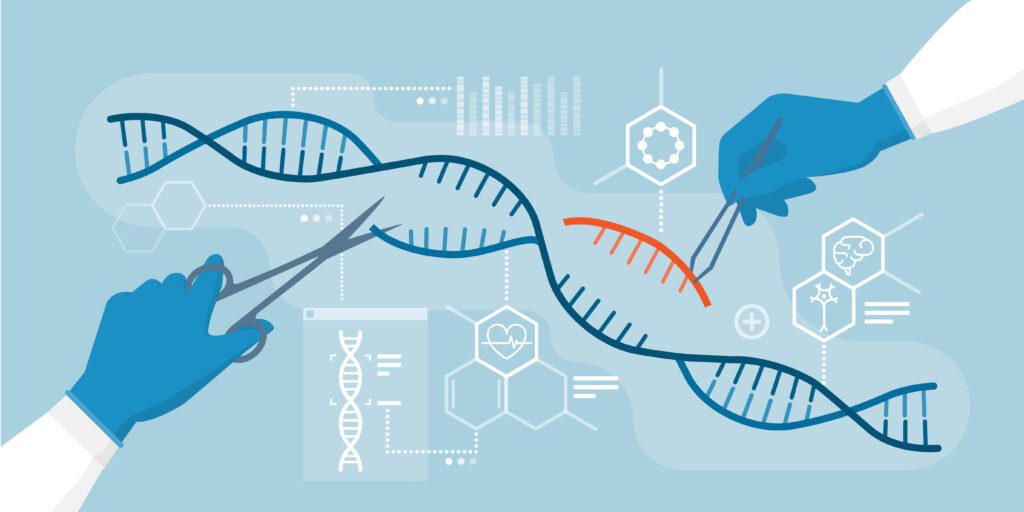
A recent study published in the Journal of the Proceedings of the National Academy of Sciences (PNAS), PNAS Nexus, titled “Trisomic rescue via allele-specific multiple chromosome cleavage using CRISPR-Cas9 in trisomy 21 cells“, scientists investigated a novel approach to identifying how they may remove the third copy of chromosome 21 from cells. They tested a new gene-editing method using CRISPR-Cas9 to eliminate the extra chromosome in lab-grown human cells selectively. Their goal was to see if they could restore a normal chromosome count safely and effectively without harming the cells.
What is CRISPR-Cas9?
CRISPR-Cas9 is a gene editing tool that allows researchers to target (cut) a known DNA sequence in a cell and repair the sequence. Due to years of research, researchers have identified DNA sequences linked to disease. Known DNA sequences are used to tell researchers what genes cause disease. If a genetic sequence has an error, scientists can target the incorrect sequence and repair it with the correct sequence. Cas9 is an enzyme scientists use to make a cut – like a pair of scissors, into the DNA. Once a cut is made in the DNA, a new sequence can be inserted and the cell will repair itself, but the genetic code will be different, which can help to improve health. If a cut is made but a new code is not inserted, that DNA sequence will not be repaired when the cell replicates.
CRISPR-Cas9 and Down syndrome
In this new study, researchers were able to use CRISPR-Cas9 to make a cut in the third copy of the 21st chromosome. As cells grew, and replicated, the new cells produced only two copies of chromosome 21, instead of three. This study was done using cells in a culture or petri dish. This study opens up the possibility to understand why people with Down syndrome, or three copies of the 21st chromosome, are more disposed to certain health conditions than individuals without Down syndrome.
In this study, the scientists used a unique gene-editing tool called CRISPR-Cas9 to eliminate the extra copy of chromosome 21.
When CRISPR-Cas9 cuts, the extra chromosome becomes unstable and is lost during cell division, allowing new cells to present with only two copies of the 21st chromosome instead of three. The edited cells continued to grow normally, showing that removing the extra chromosome restored regular gene activity in cells.
This study shows a possible future for helping scientists to understand why people with Down syndrome are more likely to get certain health conditions than people who do not have Down syndrome.
Key Findings
- The method did not significantly impact cell growth or viability, indicating a potential for therapeutic application. Past methods to eliminate extra chromosomes either involved genome modification (unsuitable for clinical use) or had low success rates. The study’s approach simplifies this process, increasing efficiency.
- While the CRISPR/Cas9 approach successfully eliminates the extra chromosome 21, it can introduce mutations in the genome, especially if the targeted chromosome is not entirely removed. The study highlights the importance of further refining the technique to ensure greater precision and safety for potential therapeutic applications.
- The study was performed on a limited number of cell types and did not include full genome sequencing after all treatments. More research is needed to test this approach in different cell types, improve efficiency, and ensure safety.
- This study does not yet demonstrate scientists’ ability to cure Down syndrome. More research is needed to understand how other cell types and organism models can handle these gene-editing methods.
Conclusion
The study provides hope for a future where genetic conditions like Down syndrome could be better understood at the DNA or genetic level.
This research offers a significant advancement in genetic medicine, demonstrating the feasibility of using CRISPR-Cas9 for chromosome-specific editing to correct genetic disorders like Down syndrome.
While this research is still in its early stages, it is an exciting step toward developing new treatments for trisomy conditions. If scientists continue improving this method, it could one day lead to medical breakthroughs that help people with Down syndrome and other genetic disorders. However, comprehensive evaluations are essential before considering clinical applications.
More studies are needed to ensure it is safe and effective in different types of cells and living organisms. Important ethical questions about using gene editing in humans also need to be carefully considered.